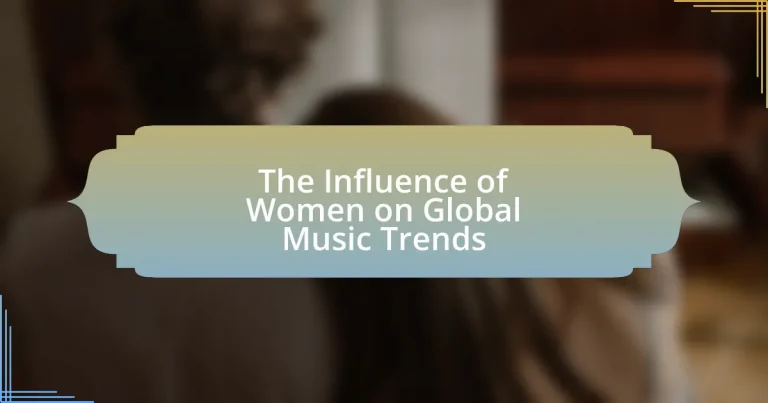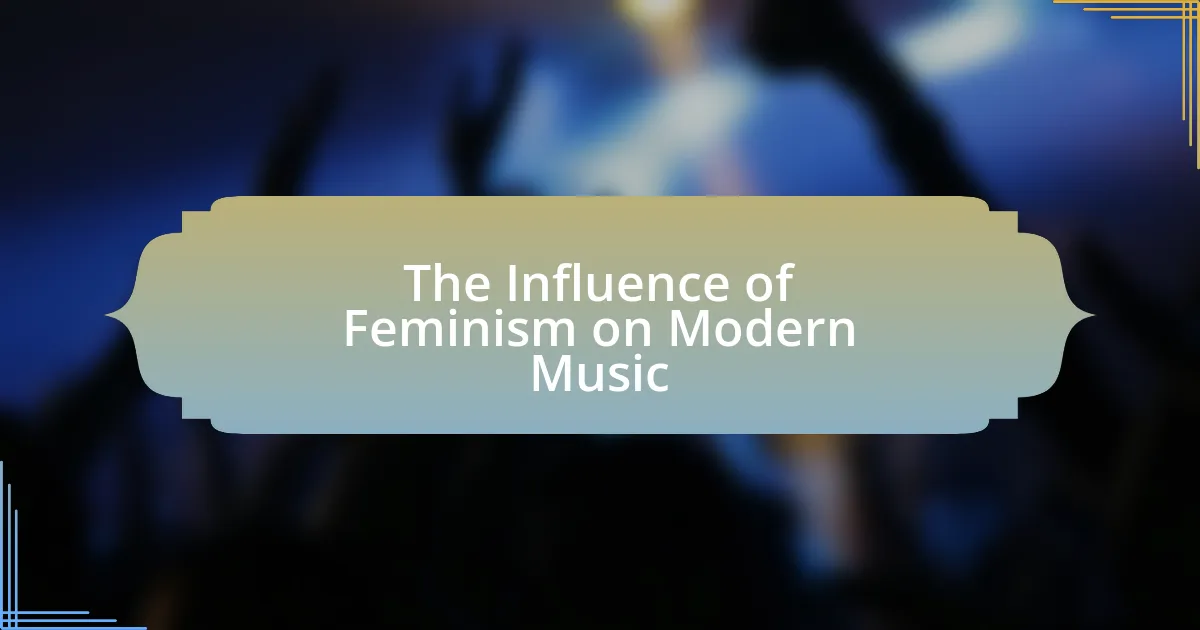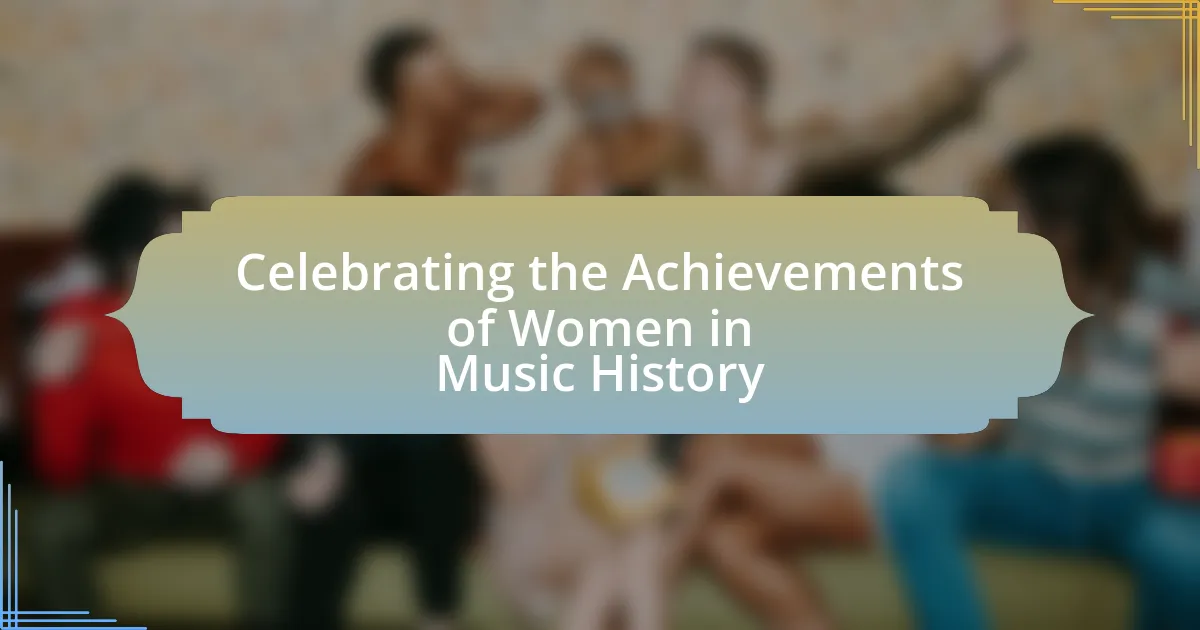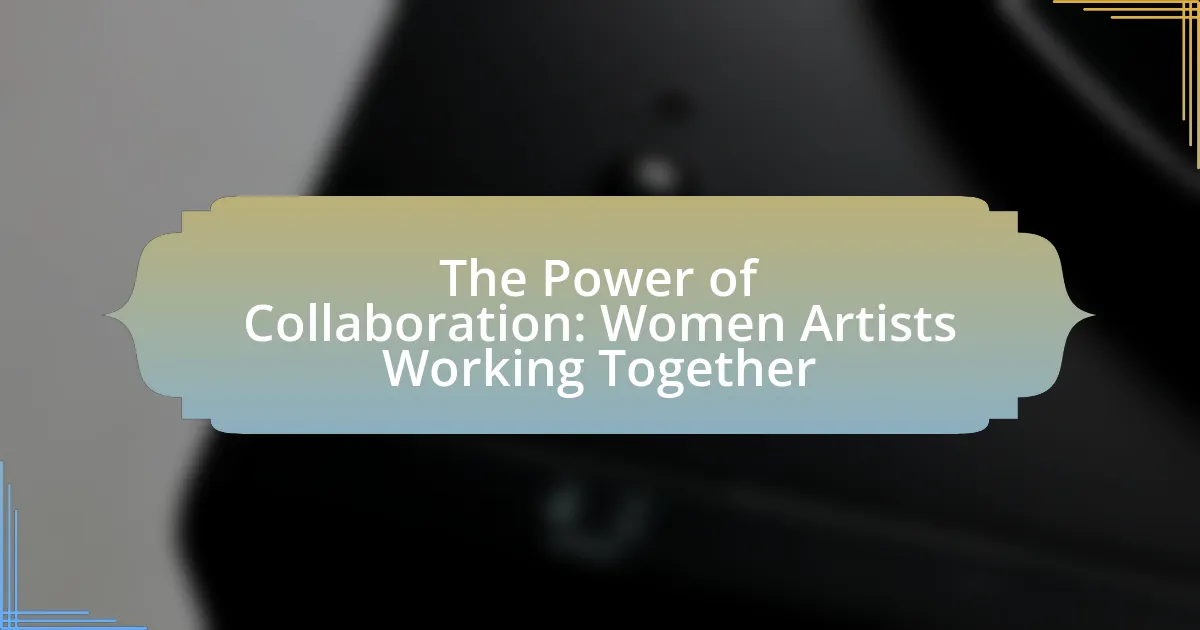The article examines the significant influence of women on global music trends, highlighting their roles in shaping genres, driving cultural movements, and redefining industry standards. It discusses historical contributions from pioneering artists, the impact of societal changes on women’s roles in music, and current trends driven by female artists across various genres. Key milestones, challenges faced by women in the industry, and the importance of representation are also explored, along with initiatives aimed at empowering female musicians and enhancing their visibility. The article underscores the economic impact of women in music and their ability to influence cultural movements through activism and collaboration.
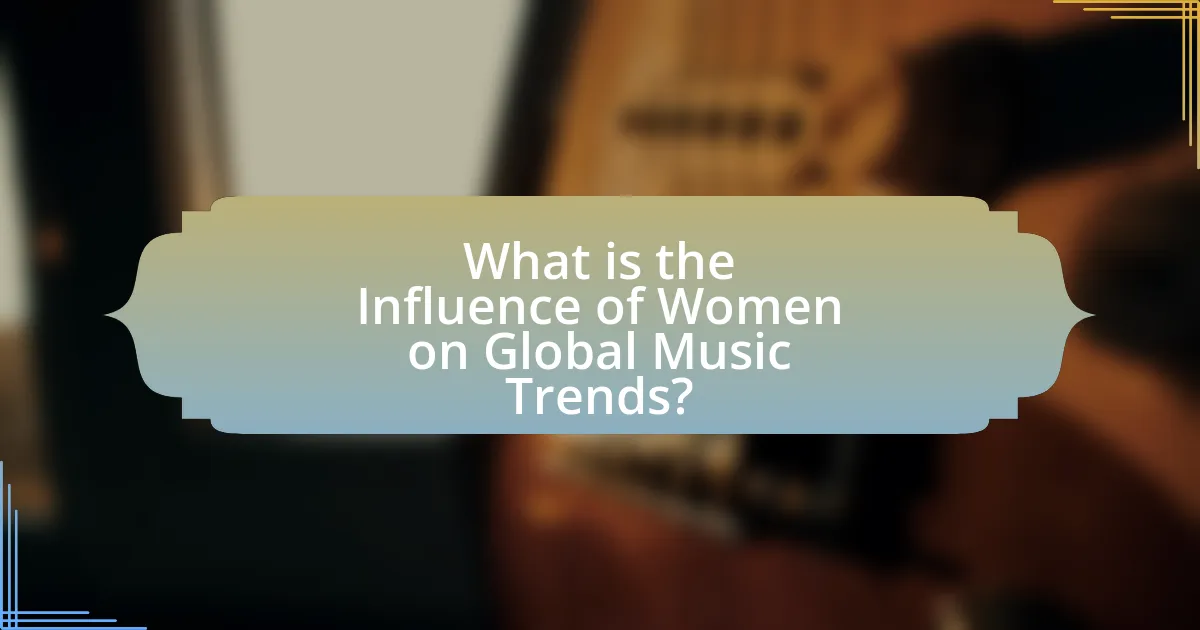
What is the Influence of Women on Global Music Trends?
Women significantly influence global music trends by shaping genres, driving cultural movements, and redefining industry standards. For instance, artists like Beyoncé and Taylor Swift have not only topped charts but also set new benchmarks for artistic expression and social activism within their music. Research from the University of Southern California’s Annenberg Inclusion Initiative highlights that women are increasingly taking on leadership roles in music production and songwriting, contributing to a more diverse soundscape. Furthermore, the rise of female-led genres such as pop, hip-hop, and country reflects their ability to connect with audiences on a global scale, as evidenced by the success of artists like Billie Eilish and Shakira, who have garnered millions of streams and awards. This impact is further validated by the growing presence of women in music festivals and award shows, where they are recognized for their contributions and influence.
How have women shaped the music industry historically?
Women have historically shaped the music industry by breaking barriers, influencing genres, and driving social change. Pioneers like Aretha Franklin and Billie Holiday not only defined the sound of their eras but also addressed social issues through their music, impacting civil rights movements. Additionally, artists such as Madonna and Beyoncé have redefined the role of women in pop culture, using their platforms to advocate for gender equality and empowerment. The presence of women in various roles, from songwriting to production, has increased significantly, with statistics showing that female songwriters accounted for 12.3% of the top 100 songs in 2020, highlighting their growing influence.
What key milestones mark women’s contributions to music?
Key milestones marking women’s contributions to music include the establishment of women composers in the 18th and 19th centuries, such as Fanny Mendelssohn and Clara Schumann, who gained recognition in a male-dominated field. The 20th century saw significant advancements with artists like Billie Holiday and Ella Fitzgerald, who transformed jazz and popular music, paving the way for future generations. Additionally, the feminist music movement of the 1970s highlighted women’s roles in music production and performance, leading to increased visibility and opportunities. The rise of female pop icons in the late 20th and early 21st centuries, such as Madonna and Beyoncé, further solidified women’s influence in shaping global music trends. These milestones collectively demonstrate the evolving role of women in music history and their impact on various genres.
How have societal changes influenced women’s roles in music?
Societal changes have significantly influenced women’s roles in music by expanding opportunities for participation and recognition. The feminist movements of the 1960s and 1970s challenged traditional gender roles, leading to increased visibility of female musicians across genres. For instance, the rise of women in rock, pop, and hip-hop has been documented, with artists like Janis Joplin and Madonna breaking barriers and reshaping industry norms. Additionally, the #MeToo movement has prompted discussions about gender equality in the music industry, resulting in initiatives aimed at supporting female artists and addressing issues of harassment. These societal shifts have not only allowed women to take on more prominent roles as performers and creators but have also fostered a more inclusive environment that celebrates diverse voices in music.
What are the current trends influenced by female artists?
Current trends influenced by female artists include the rise of genre-blending, increased representation in music production, and the use of social media for direct fan engagement. Female artists like Billie Eilish and Lizzo have popularized the fusion of pop with elements of hip-hop and electronic music, showcasing versatility and innovation. Furthermore, women are increasingly taking on roles as producers and songwriters, exemplified by artists such as Taylor Swift and Halsey, who actively participate in the creative process. Social media platforms like TikTok have become essential for female artists to connect with audiences, as seen with the viral success of songs by artists like Doja Cat. These trends reflect a significant shift towards inclusivity and diversity in the music industry, driven by the influence of female artists.
Which genres are most impacted by women’s contributions?
Women have significantly impacted genres such as pop, rock, jazz, and country music. In pop music, artists like Madonna and Beyoncé have shaped the genre’s direction and commercial success, with Madonna being recognized as the best-selling female recording artist of all time. In rock, women like Joan Jett and Stevie Nicks have not only influenced the sound but also paved the way for future female musicians. Jazz has seen contributions from legends like Ella Fitzgerald and Billie Holiday, who transformed vocal techniques and improvisation. In country music, artists such as Dolly Parton and Shania Twain have redefined the genre, with Twain holding the record for the best-selling female country artist. These contributions highlight the essential role women play in shaping and evolving musical genres.
How do female artists redefine musical styles and themes?
Female artists redefine musical styles and themes by infusing their unique perspectives and experiences into their music, often challenging traditional norms. For instance, artists like Billie Eilish and Lizzo have incorporated elements of pop, hip-hop, and electronic music while addressing themes of mental health, body positivity, and empowerment, which resonate with diverse audiences. This shift not only broadens the scope of musical genres but also encourages a more inclusive dialogue around societal issues. Historical data shows that female musicians have consistently pushed boundaries; for example, Madonna’s blending of pop with provocative themes in the 1980s paved the way for future artists to explore complex narratives in their work.
Why is representation of women in music important?
Representation of women in music is important because it fosters diversity, promotes equality, and influences cultural narratives. When women are represented in music, they challenge stereotypes and provide role models for future generations, thereby encouraging more inclusive participation in the industry. Studies show that female artists contribute significantly to various genres, with women making up 22% of artists on the Billboard Hot 100 in 2020, highlighting their impact on mainstream music. Furthermore, representation leads to a broader range of perspectives and experiences in songwriting and performance, enriching the overall music landscape.
What impact does female representation have on audiences?
Female representation significantly enhances audience engagement and relatability. Research indicates that diverse representation, particularly of women, fosters a sense of inclusion and connection among viewers, leading to increased emotional investment in the content. For instance, a study by the Geena Davis Institute on Gender in Media found that films with strong female leads attract larger audiences and generate higher box office revenues, demonstrating that audiences respond positively to female representation. This impact is further evidenced by the rise of female artists in global music trends, where their visibility not only challenges stereotypes but also inspires a broader demographic, encouraging both female empowerment and audience loyalty.
How does diversity among female artists affect music trends?
Diversity among female artists significantly influences music trends by introducing a variety of styles, perspectives, and cultural influences that reshape the musical landscape. For instance, the rise of artists from different ethnic backgrounds, such as Latin, African, and Asian influences, has led to the incorporation of diverse genres like reggaeton, Afrobeats, and K-pop into mainstream music. This blending of styles not only broadens the appeal of music but also encourages innovation, as seen in the collaborations between artists from different genres, which often result in chart-topping hits. Furthermore, research indicates that diverse representation in music leads to increased audience engagement and a wider listener base, as seen in the success of female artists like Shakira and BTS, who have transcended cultural barriers and achieved global recognition.
How do women collaborate and support each other in the music industry?
Women in the music industry collaborate and support each other through mentorship, networking, and collective initiatives. For instance, organizations like Women in Music and She Is The Music provide platforms for women to connect, share resources, and promote each other’s work. Research shows that female artists often engage in collaborative projects, such as co-writing songs or featuring on each other’s tracks, which not only enhances their visibility but also fosters a sense of community. Additionally, events like the Women’s Music Summit focus on empowering women by offering workshops and discussions that encourage collaboration and support. These efforts contribute to a more inclusive environment, enabling women to navigate the industry more effectively and amplify their voices.
What challenges do women face in the music industry?
Women in the music industry face significant challenges, including gender discrimination, unequal pay, and limited access to opportunities. Research indicates that women are underrepresented in key roles, with only 21% of songwriters and 12% of producers being female, according to a 2021 report by the Annenberg Inclusion Initiative. Additionally, women often encounter barriers in networking and mentorship, which are crucial for career advancement. These systemic issues contribute to a culture that can marginalize female artists and professionals, impacting their visibility and success in the industry.
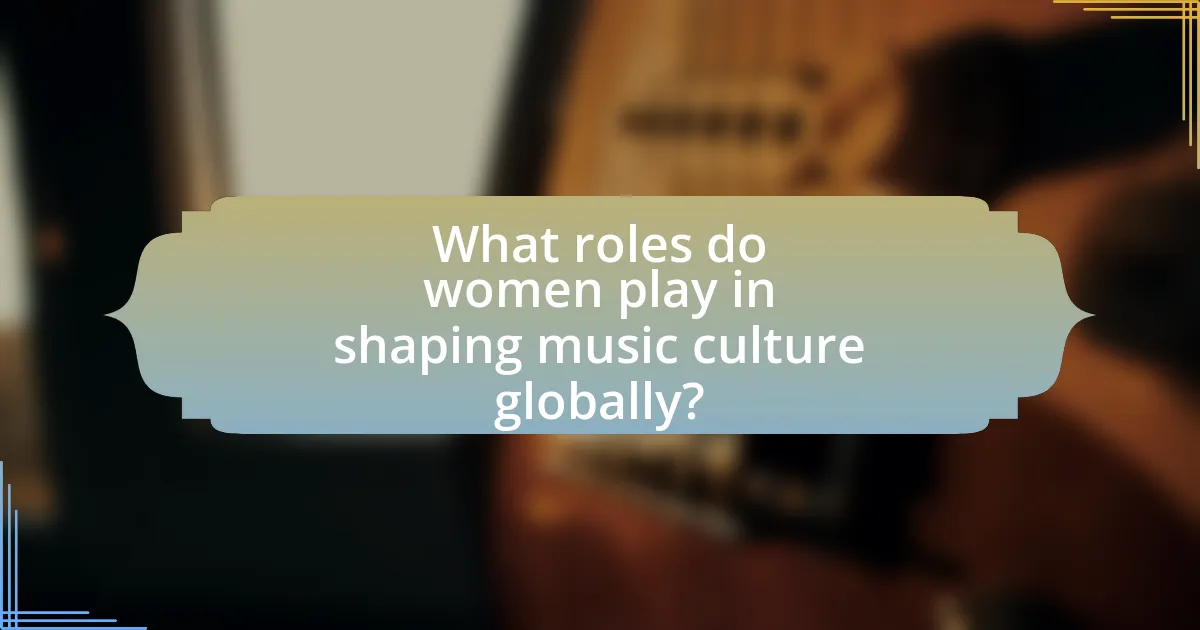
What roles do women play in shaping music culture globally?
Women play crucial roles in shaping music culture globally by serving as artists, producers, and influencers who drive innovation and diversity in musical genres. Historically, women have been pivotal in genres such as jazz, rock, and hip-hop, with figures like Billie Holiday, Joan Jett, and Missy Elliott redefining their respective styles and influencing countless others. Additionally, women contribute significantly to the music industry as songwriters and executives, with statistics showing that female songwriters have increased their presence in top charts, thereby impacting mainstream music trends. Their involvement not only enriches the cultural landscape but also challenges societal norms, promoting gender equality within the industry.
How do female musicians influence cultural movements?
Female musicians influence cultural movements by challenging societal norms and promoting social change through their art. For instance, artists like Billie Holiday and Nina Simone used their music to address racial injustice and civil rights issues, significantly impacting the cultural landscape of their time. Additionally, contemporary musicians such as Beyoncé and Taylor Swift advocate for gender equality and LGBTQ+ rights, further shaping public discourse and inspiring activism. Research indicates that female artists often serve as role models, empowering listeners to engage in cultural and political movements, thereby reinforcing the connection between music and societal transformation.
What examples illustrate women’s impact on social issues through music?
Women have significantly impacted social issues through music, exemplified by artists like Billie Holiday, whose song “Strange Fruit” addressed racial violence and lynching in America, raising awareness and prompting discussions on racism. Similarly, Joan Baez and Bob Dylan’s collaboration on “Blowin’ in the Wind” highlighted civil rights and anti-war sentiments during the 1960s, influencing public opinion and activism. Additionally, Beyoncé’s “Formation” addresses police brutality and Black empowerment, contributing to the Black Lives Matter movement. These examples demonstrate how women’s music has not only reflected societal issues but also inspired change and mobilized communities.
How do women use music as a platform for activism?
Women use music as a platform for activism by addressing social issues, promoting equality, and raising awareness through their lyrics and performances. For instance, artists like Beyoncé and Billie Eilish have tackled themes such as racial injustice and mental health, respectively, using their songs to inspire change and mobilize audiences. Historical examples include the 1960s civil rights movement, where artists like Nina Simone used music to voice the struggles of African Americans, effectively influencing public opinion and policy. Additionally, the #MeToo movement has seen artists like Lady Gaga and Kesha use their platforms to advocate against sexual violence, demonstrating the powerful intersection of music and social activism.
What are the economic impacts of women in the music industry?
Women in the music industry significantly contribute to economic growth through increased revenue generation, job creation, and market expansion. Their presence has led to a diversification of music genres and styles, attracting broader audiences and driving sales in both recorded music and live performances. For instance, a report by the Annenberg Inclusion Initiative found that female artists generated over $1 billion in revenue in 2019 alone, highlighting their financial impact. Additionally, women in leadership roles within music companies have been shown to enhance profitability and innovation, as companies with diverse leadership teams perform better financially. This evidence underscores the vital economic role women play in shaping the music industry.
How do female-led initiatives contribute to the music economy?
Female-led initiatives significantly contribute to the music economy by promoting diversity, innovation, and representation within the industry. These initiatives often focus on empowering women artists, producers, and executives, which leads to a broader range of musical styles and perspectives. For instance, organizations like Women in Music and She Is The Music provide resources, networking opportunities, and mentorship, resulting in increased visibility and career advancement for female musicians. According to a 2021 report by the Annenberg Inclusion Initiative, female artists accounted for only 22.5% of all artists on the Billboard Hot 100, highlighting the need for initiatives that address gender disparities. By fostering an inclusive environment, female-led initiatives not only enhance the creative landscape but also drive economic growth through increased sales, streaming, and concert attendance associated with diverse musical offerings.
What financial challenges do women face in the industry?
Women in the music industry face significant financial challenges, including gender pay gaps, limited access to funding, and underrepresentation in high-paying roles. Research indicates that female musicians earn approximately 30% less than their male counterparts, which is compounded by fewer opportunities for lucrative contracts and sponsorships. Additionally, women often encounter barriers when seeking investment for projects, as studies show that only 13% of music producers are women, limiting their influence and financial backing in the industry. These factors collectively hinder women’s financial stability and growth within the music sector.
How can we support and promote women’s influence in music?
To support and promote women’s influence in music, it is essential to increase visibility and representation of female artists in all aspects of the industry, including production, songwriting, and performance. Research shows that women make up only about 21% of artists in popular music, highlighting the need for initiatives that prioritize gender equity. Programs such as mentorship opportunities, funding for female-led projects, and platforms that showcase women’s work can significantly enhance their presence and influence. Additionally, organizations like Women in Music advocate for policy changes and provide resources to empower women in the industry, further validating the importance of structured support systems.
What initiatives exist to empower women in music?
Numerous initiatives exist to empower women in music, including organizations like Women in Music, which advocates for gender equality and provides networking opportunities. Additionally, the She Is The Music initiative focuses on increasing the number of women in music creation and production roles, aiming to address the gender imbalance in the industry. Programs such as Girls Who Code also support young women interested in music technology, fostering skills in music production and sound engineering. These initiatives collectively contribute to a more inclusive music industry by providing resources, mentorship, and platforms for women artists and professionals.
How can audiences contribute to the visibility of female artists?
Audiences can contribute to the visibility of female artists by actively supporting their work through attendance at performances, sharing their music on social media, and engaging with their content online. This support increases exposure and can lead to greater recognition within the industry. For instance, a study by the Annenberg Inclusion Initiative found that female artists receive significantly less airplay and media coverage compared to their male counterparts, highlighting the need for audience advocacy to balance representation. By promoting female artists, audiences can help shift industry standards and create a more equitable music landscape.
What role do music festivals play in promoting female talent?
Music festivals play a crucial role in promoting female talent by providing a platform for women artists to showcase their work to diverse audiences. These events often feature lineups that include a significant number of female performers, which helps to challenge gender stereotypes in the music industry. For instance, festivals like Coachella and Glastonbury have made concerted efforts to increase female representation, with Coachella featuring 40% female artists in its 2020 lineup. This visibility not only elevates the profiles of female musicians but also inspires emerging artists and encourages industry stakeholders to prioritize gender diversity.
What best practices can be adopted to enhance women’s representation in music?
To enhance women’s representation in music, implementing mentorship programs that connect emerging female artists with established professionals is essential. These programs can provide guidance, networking opportunities, and industry insights that are crucial for career development. Research indicates that mentorship significantly increases the likelihood of women pursuing and succeeding in music careers, as seen in initiatives like the Women in Music Mentorship Program, which has successfully supported numerous female musicians in advancing their careers. Additionally, promoting female-led music festivals and events can create platforms for women to showcase their talents, thereby increasing visibility and representation in the industry. Statistics show that festivals featuring diverse lineups attract larger audiences, highlighting the demand for female artists. Lastly, advocating for equitable hiring practices within music organizations can ensure that women are represented in decision-making roles, further influencing the industry’s landscape.
